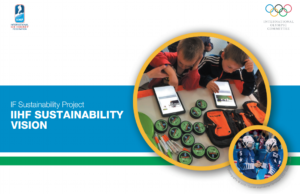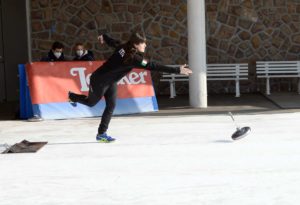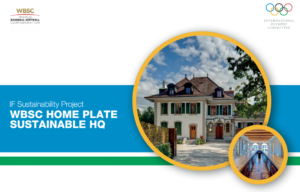
F1 to eliminate single-use plastic bottles for staff in 2021
Formula 1 has made a commitment in 2021 to eliminating single-use plastic bottles among its personnel while at racetracks, as part of a wide-ranging […]

Marathon running leaves a significant carbon footprint regarding CO2 emissions; for example, 37 percent of New York Marathon participants travel internationally to New York. The aim of this study is to estimate the CO2 footprint of a person training and competing in a marathon; we will also propose methods to minimize the CO2 footprint because of transportation.
In addition, we also examine the influence of food practices and hygiene on training and racing a marathon. Methods: We estimated the annual carbon footprint of one person taking part in a marathon. We considered all training, racing, and travelling (local and international) for one person (we are going to give him the first name of “Henri”), and then compared his CO2 footprint with his colleagues playing tennis and soccer. The excess CO2 footprint whilst running and for shoes, clothing, books, magazines, insurance, travel, hygiene, laundry, and resources for electronics and additional food consumed were calculated. For competitions, we estimated and compared the CO2 emission from transportation to national vs. international marathon (New York).
Results: We estimated that our runner emitted 4.3 tons of CO2 equivalent (CO2e), including all greenhouse gases. A transatlantic flight to New York corresponded to 3.5 tons CO2, which is 83% of the annual carbon footprint of an average French citizen which is about 11 tons CO2e/year. This leads to a sudden 40% increase in Henri’s annual carbon footprint.
Conclusions: By focusing on the additional carbon footprint from one year of marathon training and racing, and traveling locally versus internationally, this sport still has a potentially significant carbon footprint that runners and race organizers ought to consider. We wanted to answer a growing question of marathon runners who are wondering about the carbon footprint of their sports practice in following with a new environmentalist trend that considers not traveling anymore to participate in marathons and to stay local. However, the representativeness in the selection of calculation objectives is very low. There is no need for statistics since this study is a theoretical simulation of traditional training and competition practices of marathon runners.


SailGP seeks green cities to fill season three calendar
By Jonathan Rest SailGP, the annual sailing series, has today opened the bid process for season three, indicating that it wants to race in […]







The International Ice Hockey Federation (IIHF) has been actively committed in the pursuit of the United Nations Sustainable Development Goals (SDGs) as an integral part of its sustainability strategy. Aware of the imminent threats of climate change, IIHF has joined the IOC as a participant of the UN Sports for Climate Action Framework and pledged to stop plastic waste as part of the Clean Seas campaign.
In 2020, and five years after the publication of the “IIHF Manual for Sustainable Events”, the federation published a new document portraying the “IIHF Sustainability Vision”, a reflection of the IIHF’s aspirations in regards to sustainability within its organisation, its events and the broader ice hockey family.
The IIHF Vision for Sustainability spans across its different spheres of influence:
- As an organisation the federation follows the premise of “keeping your own house clean”. With the goal of staying as sustainable as possible, IIHF seeks to lead by example including the use of green energy, having a recycling system in place, eliminating the use of single-use plastic bottles and the promotion of water filters, generally taking a continuous improvement approach at the organisational level.
- Member National Associations (MNAs) and stakeholders are encouraged to have their own sustainability strategies responding to their resources and local contexts. The federation recognises best sustainability practices amongst its members since 2019 through its IIHF Sustainability Award.
- IIHF Events are asked to follow the IIHF Manual for Sustainable Events designed to make sustainability an integral, and easy to apply, component of event planning.
However, the manual is not meant as a one-size-fits-all document, but rather a guide that can allow any organiser to be flexible.
BENEFITS
- By creating opportunities to communicate actions by its members and stakeholders, an IF can serve to multiply the effect of positive initiatives by promoting ideas and collaboration.
- The publication of a vision can serve internally as a reference of direction but it can also have external effects. It can create awareness on what is relevant to the organisation and foster relationships with current and potential stakeholders, such as new possible sponsors, which can align and support that vision.
Click here to download the case study









Global sports community to celebrate International Women’s Day
The global sports community will celebrate #InternationalWomensDay on Monday 8 March, a day marked around the world to recognise the social, economic, cultural and […]


Protecting the environment as a project for an IOC Young leader
Canada’s Oluseyi “Seyi” Smith is one of the rare athletes to have taken part in both the Games of the Olympiad, in athletics, and […]


IFI signs up to United Nations Sports for Climate Action initiative
The International Federation Icestocksport (IFI) is proud to announce that we have joined the UNFCCC’s Sports for Climate Action initiative as a signatory to […]


Sustainability is the goal as Glion helps floorballers make a commitment to the environment
A group of Glion students have shown that sport and sustainability can be a powerful mixture, thanks to an Applied Business Project that’s given […]



WBSC Home Plate sustainability HQ
The World Baseball Softball Confederation (WBSC) officially opened “Home Plate” on July 2020, its new headquarters in Switzerland, designed with sustainability at its heart. The move follows the merger in 2013 of the International Baseball Federation and the International Softball Federation and the acquisition in 2018 of the building which, after a complete renovation, now hosts its joint federation.
Seeking to leave a positive legacy for its community, sustainability was embedded in every step of the planning, conditioning and intended use of its new headquarters.
Twenty-four roof top photovoltaic panels, with a power output of 12 kilowatts, provide approximately 10% of the building’s electricity needs with the goal of increasing the capacity to cover 100% of its needs by 2025. The underfloor heating and cooling system use hot and cold water to maintain an ideal office climate, whilst all walls have been insulated with high density stone wool allowing temperatures to be maintained for up to 20 hours after the system has been switched off. The same stone wool increases fire resistance and acoustic comfort. All the lighting is made with LED technology and occupancy sensors to keep energy consumption levels to a minimum. The interior Saint-Gobain glass walls and doors feature fire resistant Ei-60 glass - double of the requirement by law.
BENEFITS
- The WBSC now has a sustainable, state-of-the-art permanent headquarters to allow for further, and conscious, growth.
- The new headquarters have significantly improved the working environment and team spirit amongst the staff.
- The sustainability of the building is a source of inspiration to the staff to come up with their own ideas for making their working environment even more sustainable.
Click here to download the case study







Put your climate knowledge to the test!
Just recently the IFF published the results of the fan survey on environmental topics. In the spirit of the inspiring results we challenge the […]
